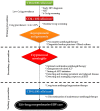HIV-Associated Cryptococcal Disease in Resource-Limited Settings: A Case for "Prevention Is Better Than Cure"?
- PMID: 29371581
- PMCID: PMC5753169
- DOI: 10.3390/jof3040067
HIV-Associated Cryptococcal Disease in Resource-Limited Settings: A Case for "Prevention Is Better Than Cure"?
Abstract
Cryptococcal disease remains a significant source of global morbidity and mortality for people living with HIV, especially in resource-limited settings. The recently updated estimate of cryptococcal disease revealed a global incidence of 223,100 cases annually with 73% of these cases being diagnosed in sub-Saharan Africa. Furthermore, 75% of the estimated 181,100 deaths associated with cryptococcal disease occur in sub-Saharan Africa. Point-of-care diagnostic assays have revolutionised the diagnosis of this deadly opportunistic infection. The theory of asymptomatic cryptococcal antigenaemia as a forerunner to symptomatic meningitis and death has been conclusively proven. Thus, cryptococcal antigenaemia screening coupled with pre-emptive antifungal therapy has been demonstrated as a cost-effective strategy with survival benefits and has been incorporated into HIV national guidelines in several countries. However, this is yet to be implemented in a number of other high HIV burden countries. Flucytosine-based combination therapy during the induction phase is associated with improved survival, faster cerebrospinal fluid sterilisation and fewer relapses. Flucytosine, however, is unavailable in many parts of the world. Studies are ongoing on the efficacy of shorter regimens of amphotericin B. Early diagnosis, proactive antifungal therapy with concurrent management of raised intracranial pressure creates the potential to markedly reduce mortality associated with this disease.
Keywords: cryptococcal disease; cryptococcal polysaccharide capsular antigen (CrAg) test; prevention and treatment; resource-limited settings.
Conflict of interest statement
David W. Denning and family hold Founder shares in F2G Ltd., a University of Manchester spin-out antifungal discovery company. He acts or has recently acted as a consultant to Astellas, Sigma Tau, Basilea, Scynexis, Cidara, Biosergen, Quintiles, Pulmatrix, Pulmocide and Zambon. In the last three years, he has been paid for talks on behalf of Astellas, Dynamiker, Gilead, Merck and Pfizer. He is a longstanding member of the Infectious Disease Society of America Aspergillosis Guidelines group, the European Society for Clinical Microbiology and Infectious Diseases Aspergillosis Guidelines group and the British Society for Medical Mycology Standards of Care committee. Felix Bongomin, Rita O Oladele, and Sara Gago declare no conflicts of interest.
Figures




References
Publication types
LinkOut - more resources
Full Text Sources
Other Literature Sources

